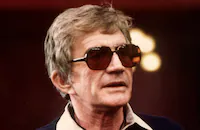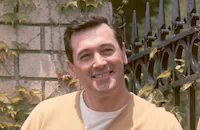Darling Lili

Brief Synopsis
Cast & Crew
Blake Edwards
Julie Andrews
Rock Hudson
Jeremy Kemp
Lance Percival
Michael Witney
Film Details
Technical Specs

Synopsis
During the Great War, Lili Smith, a popular singer with London audiences, acts as a German agent. Her assignment, relayed by superior Kurt von Ruger, is to develop a friendship with American officer Maj. William Larrabee. While in France to receive the Legion of Honor award for patriotism, Lili meets the flier. Impressed by her compassion for the wounded and infatuated by her charm, Larrabee courts her, employing gypsy violinists to serenade her. As a result, Lili easily elicits military information from him. Discovering the security leak and suspecting the American, French intelligence officers enlist Lili's aid in unmasking the spy. Informed by von Ruger that Larrabee is involved in Operation Crêpe Suzette, Lili discovers that Suzette is Larrabee's stripper mistress and denounces her rival as the German agent. While on a rescue mission the flier is downed. Commandeering the plane of German ace von Richthofen, however, he escapes to England. When Larrabee is arrested for espionage, Lili comes to his aid, proclaiming her identity and outraging her German superiors. Fearing for Lili's life, Larrabee once again takes command of von Richthofen's plane and saves her train from a German air attack. From the sky the flier throws his scarf as a symbol of their love. After the armistice Lili resumes her singing career. During a performance Larrabee steps from the stage wing and embraces her. Traditional songs : "It's a Long, Long Way to Tipperary," "Pack Up Your Troubles in Your Old Kit Bag and Smile, Smile, Smile," "Keep the Home Fires Burning," and "Mademoiselle From Armentières" (sung by Lili and chorus).

Director

Blake Edwards
Cast

Julie Andrews

Rock Hudson
Jeremy Kemp
Lance Percival
Michael Witney
Gloria Paul
Jacques Marin
André Maranne
Bernard Kay
Doreen Keogh
Carl Duering
Vernon Dobtcheff

Laurie Main
Louis Mercier
Arthur Gould-porter
Ingo Mogendorf
Niall Macginnis
Mimi Monti
Crew
Reg Allen
Jack Bear
William Peter Blatty
Donald Brooks
Willard Buell
Bea Busch
Fernando Carrère
John Carter
John Coonan
Alan Copeland
Dick Crockett
Owen Crump
Linwood Dunn
Blake Edwards
Blake Edwards
Blake Edwards
Derek Goddard
Danny Gould
Russell Harlan
Marvin Hime
Fred Hynes
Irish Air Corps
James Lanphier
Michel Legrand
Fred Lemoine
Harper Mackay
Henry Mancini
Henry Mancini
Gene Marum
Danielle Mauroy
Mickey Mccardle
Jack Mcedward
Johnny Mercer
Curtis Mick
Wally Oliver
Hermes Pan
Bob Peterson
Derek Piggott
William R. Poole
Lynn Reynolds
Lorraine Roberson
Howard Roessel
Claude Joseph Rouget De Lisle
Allan Snyder
Anthony Squire
Frank Stanley
Jack Stevens
Guy Tabary
Lois Thurman
Van Der Veer Photo Co.
Ken Wales
Harold E. Wellman
Jack Whitman
Rex Wimpy
Peter Zinner

Film Details
Technical Specs

Award Nominations
Best Costume Design
Best Score
Best Song
Articles
Darling Lili
Director Blake Edwards and Julie Andrews had fallen in love in 1968. Edwards remembered that time in a December 1982 interview with Playboy Magazine, "The real meeting and kind of getting to know each other and being turned on to each other, I guess, was when I went to see Julie about doing Darling Lili [1970]." Both had a goal in mind: to change Andrews' sugary sweet screen image by making her sexy. As the ads for the film proclaimed, "she sizzles, she dances, she spies." The "sizzle" came from Edwards shooting love scenes between Andrews and co-star Rock Hudson, even going so far as to show them in the shower together. As with many Julie Andrews films, there is plenty of dancing, although in Darling Lili, Edwards adds a twist by having Andrews turn a music hall performance into a striptease. To complete the transformation, Andrews' character, Lili, is a German espionage agent a la Mata Hari, who risks her life by spying against the English during World War I. When she is assigned to vamp an American pilot (Hudson) to get information, Lili falls in love and must choose between her country and her man.
The Edwards/Andrews romance seems to have been the only bright spot in what would become a very troubled production. Filming began in late March 1968, a few weeks before the now famous Paris student uprising in May. France was brought to a halt by striking workers who were in solidarity with the students, making it impossible to shoot there. Production had to be moved to Brussels, and eventually Ireland, which caused Edwards even more problems. "When we were ready to film Darling Lili, I was certainly production-wise enough to know it was impractical to consider a lengthy exterior shoot in Ireland. It's not just that there isn't much sunshine there, you can shoot a movie in consistent bad weather, but you can't count on that in Ireland, either. There are days when either it's pissing rain or you get intermittent sun, for the most part, Ireland's just a bad place to shoot a movie. I investigated that immediately and wanted to shoot the aircraft sequences in South Carolina, which can be made to look like German or French countryside, but Paramount stuck to its decision to shoot in Ireland, so off we went. Well, the second unit ran millions of dollars over budget just waiting to get 'clear air' shots there. After that, I was under constant money pressure from the studio but that wasn't nearly as hard to take as the rest of the stuff they did to me."
By the time filming was complete, the total spent on production had risen to $25,000,000, (an astronomical sum in 1968) which nearly bankrupted Paramount Studios. They blamed Edwards and Andrews, accusing them in the press of being extravagant. Edwards defended himself in the Playboy interview, "People who were at Paramount at that time would say things to me and then deny they'd said them, and after a while, I began to doubt my own sanity. It got so serious that I finally decided I'd never take a call from them or have a conversation of importance without recording it for my own benefit...One time, the studio's Paris representative hired some French director to be in charge of our second unit and told me I'd authorized him to do that the night before. Well, I'd taped that conversation, and we'd never said a word about it. Another time, when we couldn't find an inn for some exterior shots and were running into bad weather again, I told Paramount to bring me home because I could save some money by building the goddamned thing in the studio. It took me forever to finally convince them, and in the meantime, we just sat in Paris. Well, I started thinking that maybe Charles Bluhdorn - the head of Gulf Western, which had just bought Paramount - was getting bad information. I told him that when I had a dinner with him in Paris, and he said, ?There's only one thing that's important: if this film is a success, you're a hero. If it isn't, you're finished.? That was his answer. I've got it on tape."
In the same interview, Julie Andrews remembered their life as "rather crazy at that time. We had Blake's two kids with us and my kid, and we were trying to begin a relationship while also traveling and filming. I obviously realized what was happening to Blake and empathized, because I saw many instances of things that were stupid and unfair. For example, Blake had wanted a couple of musical numbers in the film to show that Lili was an entertainer; that gave Paramount the notion to make the film into a big, big musical." Edwards continued where Andrews left off, "And because we'd spent SO much money on those second units, the studio decided to leave in as much of the aerial footage as possible just to show the money that was spent. So stupid that the film was a product of people's taking over a motion-picture company without having any credentials at all. By that, I mean Charlie Bluhdorn's giving directives and Bob [Robert] Evans, who'd hardly made a movie before, being head of the studio."
Paramount wasn't the only ones bashing Blake Edwards and Julie Andrews in the press; rumors about their sexuality began to get around Hollywood at that time. Edwards knew where they came from, "we can credit them to a miserable newspaperwoman - I won't dignify her by mentioning her name - who, shortly after Julie and I met, wrote something implying that Rock Hudson, Julie and I were a sexual threesome. She also implied that Rock and I had spent a lot of time together in San Francisco leather bars. We were shooting Darling Lili then, and I walked up to Rock and repeated the story to him, and I loved his response: "How in the hell did she find out so quick?"
When Darling Lili was finally released on June 23, 1970, the reviews were mixed. Ironically, the aerial sequences were highly praised, as was Andrews' talents as a comedienne, but as Vincent Canby wrote in his review for Variety, "As a historical note, I might also point out that Darling Lili is in itself the kind of romantic gesture we're not likely to see again for a very long time. It's the last of the mammoth movie musicals....I doubt that Hollywood, now practically broke and trying desperately to make a connection with the youth market, will ever again indulge itself in this sort of splendidly extravagant, quite frivolous enterprise." As for Julie Andrews' sexy new image, Canby echoed the sentiments of other critics when he wrote, "[Edwards] gives her a comic striptease, which only goes to prove that when you take the clothes off a Girl Guide, you've got a very naked Girl Guide."
While it garnered three Academy Award nominations for Henry Mancini and Johnny Mercer for Best Score and Best Song; and Donald Brooks and Jack Bear for Best Costume Design, an old-fashioned, glossy, "splendidly extravagant" film could do nothing but fail at the box office in 1970. Had it been released a few years earlier, it might have been more successful. Blake Edwards and Julie Andrews continued to make films together and finally managed to break Andrews free of the "Mary Poppins" image in their films 10 (1979), S.O.B. (1981, which was partly based on their experiences making Darling Lili and is remembered as the film in which Andrews did her first topless scene) and Victor/Victoria (1982). Though Darling Lili was not a financial success, for Blake Edwards and Julie Andrews their marriage which has lasted since November 12, 1969, has been their biggest success of all.
Producer: Owen Crump, Blake Edwards
Director: Blake Edwards
Screenplay: William Peter Blatty, Blake Edwards
Cinematography: Russell Harlan
Film Editing: Peter Zinner
Art Direction: Fernando Carrere
Music: Henry Mancini
Cast: Julie Andrews (Lili Smith), Rock Hudson (Maj. William Larrabee), Jeremy Kemp (Col. Kurt Von Ruger), Lance Percival (T.C.), Michael Witney (Lt. George Carson), Gloria Paul (Crepe Suzette).
C-114m. Letterboxed. Closed captioning.
by Lorraine LoBianco

Darling Lili
Quotes
Trivia
Notes
Location scenes filmed in Dublin, Brussels, and Paris. Aerial sequences filmed over Ireland.

Miscellaneous Notes
Released in United States Summer June 1970
Michel Legrand and Danielle Mauroy translated the French lyrics.
Released in United States Summer June 1970














